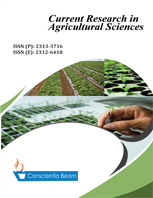Assessing grain yield of quality protein maize under low soil nitrogen through associated agronomic traits
DOI:
https://doi.org/10.18488/cras.v11i2.4006Abstract
The study was conducted to improve a quality protein maize (QPM) population, ART/98/ILE 1-OB, for tolerance to low soil nitrogen, and to investigate the agronomic characters that are linked to grain yield of QPM in low soil nitrogen environments. S1 lines were selected in the maize population at cycle one (C1) in a recurrent selection programme, for evaluation to move to cycle 2 (C2). Data were collected on agronomic traits, stay-green ability (SGR) and grain yield (GY) and analysed using SAS. SGR rating at 8 weeks after planting (8WAP) was moderate under low nitrogen (3.09). GY was slightly higher under low nitrogen (LN) (2.19 tons/ha) than under high nitrogen (HN) condition (1.98 tons/ha). There were notable negative phenotypic and genotypic correlations between grain yield (GY) and traits such as days to 50% anthesis and silking, stay green rating (SGR), ear aspect (EA), and plant aspect (PA). In contrast, positive correlations were observed with plant height (PH) and number of ears per plant (EPP). In stepwise regression, EPP emerged as the most significant character under LN (R2 = 45%), with EA, SGR at 8WAP (SGR8), and PH following closely. EPP showed the highest positive direct effect on grain yield, followed by SGR8. EA had the highest negative direct effect. PC1 alone, which was mostly linked to PH, accounted for 96.5% of the overall variation. These findings underscore the importance of EPP, EA, SGR8 and PH as selection criteria in enhancing QPM productivity under LN conditions.

